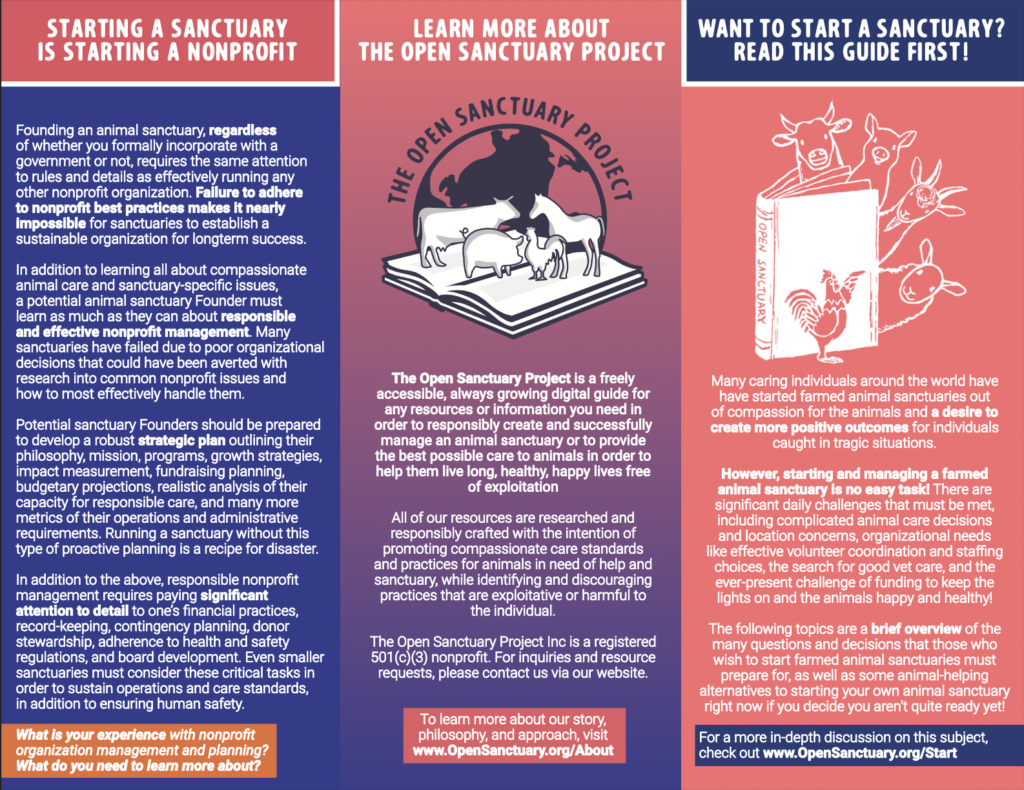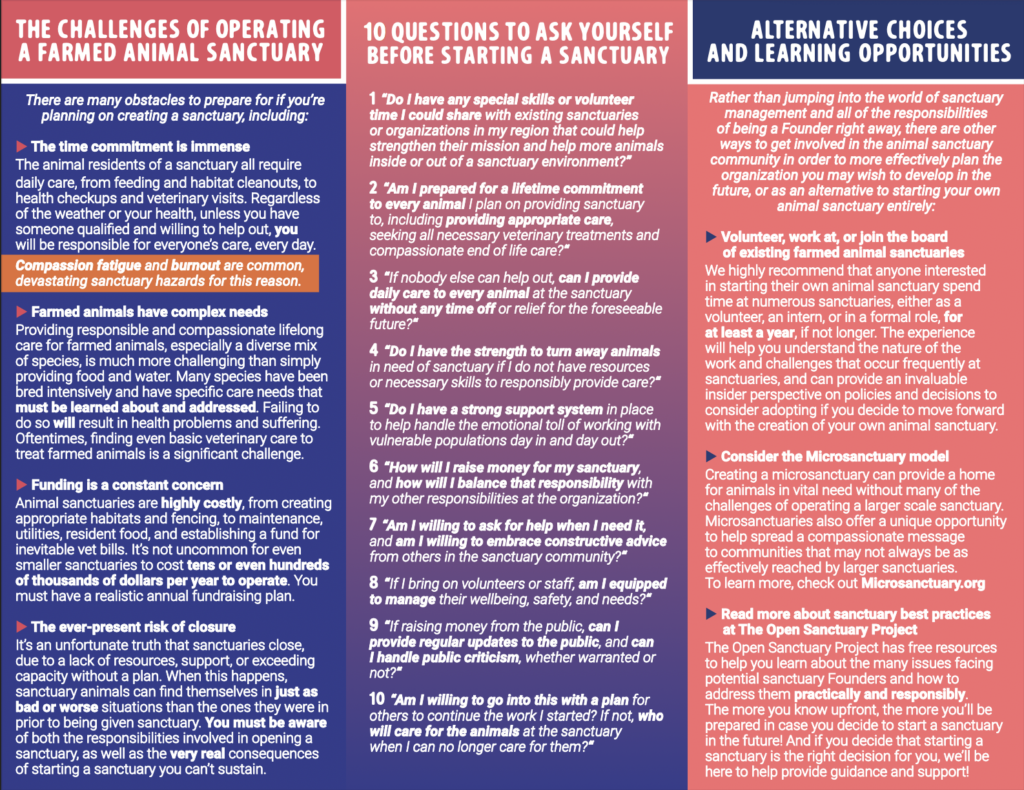

Updated June 13, 2023
Enter either your organization’s name or your name and email below to download a free brochure PDF that you can have printed out for visitors to your organization who are interested in learning more about what it takes to start an animal sanctuary. Physical literature is a great way to relay a lot of information in a pleasing way to curious individuals.
For our wider discussion on what to consider when thinking about starting a sanctuary, check out our resource here. We encourage sanctuaries to share our starter resource on their social media and on their website!
We promise not to use your email for any marketing purposes! Would you prefer to access this form in a different way? Contact us and let us know!
Have you used this form at your sanctuary and want to give us your feedback on improvements? Let us know here!
Full Text Summary Of The Brochure:
Here’s The Open Sanctuary Project’s “So You Want To Start A Sanctuary Brochure” text summary:
Panel 1:
Title: Want To Start A Sanctuary? Read This Guide First!
Text:
Many caring individuals around the world have started farmed animal sanctuariesAnimal sanctuaries that primarily care for rescued animals that were farmed by humans. out of compassion for the animals and a desire to create more positive outcomes for individuals caught in tragic situations.
However, starting and managing a farmed animal sanctuaryAn animal sanctuary that primarily cares for rescued animals that were farmed by humans. is no easy task! There are significant daily challenges that must be met, including complicated animal care decisions and location concerns, organizational needs like effective volunteer coordination and staffing choices, the search for good vet care, and the ever-present challenge of funding to keep the lights on and all of the animals happy and healthy!
The following topics are a brief overview of the many questions and decisions that those who wish to start farmed animalA species or specific breed of animal that is raised by humans for the use of their bodies or what comes from their bodies. sanctuaries must prepare for, as well as some animal-helping alternatives to starting your own animal sanctuary right now if you decide you aren’t quite ready yet!
For a more in-depth discussion on this subject, check out www.OpenSanctuary.org/Start
Photo: A pig licking the face of another pig.
Panel 2:
Title: The Challenges Of Operating A Farmed Animal Sanctuary
Text:
There are many obstacles to prepare for if you’re planning on creating a sanctuary, including:
The time commitment is immense:
The animal residents of a sanctuary all require daily care, from feeding and habitat cleanouts, to health checkups and veterinary visits. Regardless of the weather or your health, unless you have someone qualified and willing to help out, you will be responsible for everyone’s care, every day. Compassion fatigue and burnout are common, devastating sanctuary hazards for this reason.
Farmed animalsA species or specific breed of animal that is raised by humans for the use of their bodies or what comes from their bodies. have complex needs:
Providing responsible and compassionate lifelong care for farmed animals, especially a diverse mix of species, is much more challenging than simply providing food and water. Many species have been bred intensively and have specific care needs that must be learned about and addressed. Failing to do so will result in health problems and suffering. Oftentimes, finding even basic veterinary care to treat farmed animals is a significant challenge.
Funding is a constant concern:
Animal sanctuaries are highly costly, from creating appropriate habitats and fencing, to maintenance, utilities, resident food, and establishing a fund for inevitable vet bills. It’s not uncommon for even smaller sanctuaries to cost tens or even hundreds of thousands of dollars per year to operate. You must have a realistic annual fundraising plan.
The ever-present risk of closure:
It’s an unfortunate truth that sanctuaries close, due to a lack of resources, support, or exceeding capacity without a plan. When this happens, sanctuary animals can find themselves in just as bad or worse situations than the ones they were in prior to being given sanctuary. You must be aware of both the responsibilities involved in opening a sanctuary, as well as the very real consequences of starting a sanctuary you can’t sustain.
Panel 3:
Title: Starting A Sanctuary Is Starting A NonprofitA non-governmental organization whose primary purpose is something other than selling goods or services.
Text:
Founding an animal sanctuary, regardless of whether you formally incorporate with a government or not, requires the same attention to rules and details as effectively running any other nonprofit organization. Failure to adhere to nonprofit best practices makes it nearly impossible for sanctuaries to establish a sustainable organization for longterm success.
In addition to learning all about compassionate animal care and sanctuary-specific issues, a potential animal sanctuary FounderSomeone who starts an organization. A Founder may or may not also be the Executive Director of an organization. must learn as much as they can about responsible and effective nonprofit management. Many sanctuaries have failed due to poor organizational decisions that could have been averted with research into common nonprofit issues and how to most effectively handle them.
Potential sanctuary Founders should be prepared to develop a robust strategic plan outlining their philosophy, mission, programs, growth strategies, impact measurement, fundraising planning, budgetary projections, realistic analysis of their capacity for responsible care, and many more metrics of their operations and administrative requirements. Running a sanctuary without this type of proactive planning is a recipe for disaster.
In addition to the above, responsible nonprofit management requires paying significant attention to detail to one’s financial practices, record-keeping, contingency planning, donor stewardship, adherence to health and safety regulations, and board development. Even smaller sanctuaries must consider these critical tasks in order to sustain operations and care standards, in addition to ensuring human safety.
What is your experience with nonprofit organization management and planning?
What do you need to learn more about?
Panel 4:
Title: 10 Questions To Ask Yourself Before Starting A Sanctuary
Text:
- “Do I have any special skills or volunteer time I could share with existing sanctuaries or organizations in my region that could help strengthen their missionThe stated goals and activities of an organization. An animal sanctuary’s mission is commonly focused on objectives such as animal rescue and public advocacy. and help more animals inside or out of a sanctuary environment?”
- “Am I prepared for a lifetime commitment to every animal I plan on providing sanctuary to, including providing appropriate care, seeking all necessary veterinary treatments and compassionate end of life care?“
- “If nobody else can help out, can I provide daily care to every animal at the sanctuary without any time off or relief for the foreseeable future?“
- “Do I have the strength to turn away animals in need of sanctuary if I do not have resources or necessary skills to responsibly provide care?“
- “Do I have a strong support system in place to help handle the emotional toll of working with vulnerable populations day in and day out?“
- “How will I raise money for my sanctuary, and how will I balance that responsibility with my other responsibilities at the organization?“
- “Am I willing to ask for help when I need it, and am I willing to embrace constructive advice from others in the sanctuary community?“
- “If I bring on volunteers or staff, am I equipped to manage their wellbeing, safety, and needs?“
- “If raising money from the public, can I provide regular updates to the public, and can I handle public criticism, whether warranted or not?“
- “Am I willing to go into this with a plan for others to continue the work I started? If not, who will care for the animals at the sanctuary when I can no longer care for them?“
Panel 5:
Title: Alternative Choices And Learning Opportunities
Text:
Rather than jumping into the world of sanctuary management and all of the responsibilities of being a Founder right away, there are other ways to get involved in the animal sanctuary community in order to more effectively plan the organization you may wish to develop in the future, or as an alternative to starting your own animal sanctuary entirely:
Volunteer, work at, or join the board of existing farmed animal sanctuaries:
We highly recommend that anyone interested in starting their own animal sanctuary spend time at numerous sanctuaries, either as a volunteer, an intern, or in a formal role, for at least a year, if not longer. The experience will help you understand the nature of the work and challenges that occur frequently at sanctuaries, and can provide an invaluable insider perspective on policies and decisions to consider adopting if you decide to move forward with the creation of your own animal sanctuary.
Consider the MicrosanctuaryA microsanctuary is a small scale community of human and nonhuman (generally “unconventional or farmed”) animal companions, who live together in a chosen shared lifestyle and in commitment to ending the oppression of all beings. Microsanctuaries adhere to the notion that no nonhuman member of the community should “serve a purpose.” Microsanctuaries can exist in any context: rural, suburban, or urban. A microsanctuary can consist of as small a community as one animal and one human caregiver. For more information on microsanctuary please refer to the Microsanctuary Resource Center. model:
Creating a microsanctuary can provide a home for animals in vital need without many of the challenges of operating a larger scale sanctuary. MicrosanctuariesMicrosanctuaries are small scale communities of human and nonhuman (generally “unconventional or farmed”) animal companions, who live together in a chosen shared lifestyle and in commitment to ending the oppression of all beings. Microsanctuaries adhere to the notion that no nonhuman member of the community should “serve a purpose.” Microsanctuaries can exist in any context: rural, suburban, or urban. A microsanctuary can consist of as small a community as one animal and one human caregiver. For more information on microsanctuary please refer to the Microsanctuary Resource Center. also offer a unique opportunity to help spread a compassionate message to communities that may not always be as effectively reached by larger sanctuaries.
To learn more, check out Microsanctuary.org
Read more about sanctuary best practices at The Open Sanctuary Project:
The Open Sanctuary Project has free resources to help you learn about the many issues facing potential sanctuary Founders and how to address them practically and responsibly. The more you know upfront, the more you’ll be prepared in case you decide to start a sanctuary in the future! And if you decide that starting a sanctuary is the right decision for you, we’ll be here to help provide guidance and support!
Panel 6:
Title: Learn More About The Open Sanctuary Project
Graphic: The Open Sanctuary Project’s Logo
Text:
The Open Sanctuary Project is a freely accessible, always growing digital guide for any resources or information you need in order to responsibly create and successfully manage a farmed animal sanctuary, or to provide the best possible care for farmed animals in order to help them live long, healthy, happy lives free of exploitationExploitation is characterized by the abuse of a position of physical, psychological, emotional, social, or economic vulnerability to obtain agreement from someone (e.g., humans and nonhuman animals) or something (e.g, land and water) that is unable to reasonably refuse an offer or demand. It is also characterized by excessive self gain at the expense of something or someone else’s labor, well-being, and/or existence..
All of our resources are researched and responsibly crafted with the intention of maximizing compassionate ongoing care for animals in need of help and sanctuary, without any promotion or advocacy for their use.
The Open Sanctuary Project Inc is a registered 501(c)(3) nonprofit. For inquiries and resource requests, please contact us via our website.To learn more about our story, philosophy, and approach, visit www.OpenSanctuary.org/About








